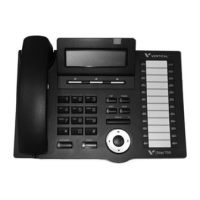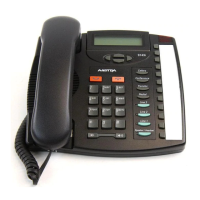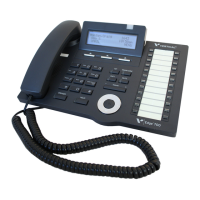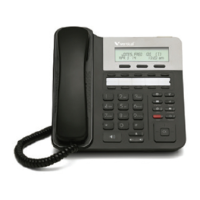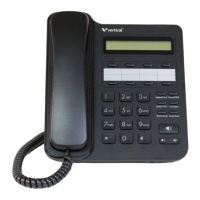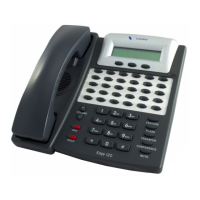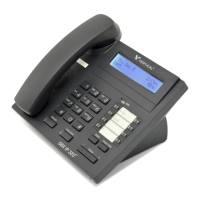Do you have a question about the Vertical summit and is the answer not in the manual?
Allows tracking of specific calls using a non-verified identifier for call cost allocation to accounts or clients.
Provides control over access to features like Voice Mail, Off Premise Call Forward, DISA, and Line access.
Allows automatic recording of calls to a Voice Mailbox or hard disk drive of UCS Client soft phone.
Incorporates flexible incoming call routing, real-time agent monitoring, supervision, and call record statistics.
Routes calls based on digits dialed by the caller, comparing them to ICLID Table entries for destination.
Details features related to agents within an ACD group, including auto connect, wrap-up, and help requests.
Automatically connects calls to agents using a headset, providing a brief tone (Zap Tone) if assigned.
Agent automatically enters a Wrap-up state after an ACD group call to complete paperwork.
Agents request assistance from a Supervisor using an ACD Help Code or a {HELP} button.
Assigns stations or 4-digit Agent Ids as members of an ACD group for login and logout participation.
Allows agents to control their status (On/Off-duty) and assign a Reason code for Off-duty states.
Agent not answering a call within the No-Answer timer is placed in a 'No response' unavailable status (ACD DND).
Routes incoming calls to the longest idle station or an announcement; queues calls or routes to an Alternate Destination if all agents are busy.
Permits active Supervisors to monitor and control agent status and calls within the ACD group.
Supervisor monitors an Agent's call for training or assistance, connected with microphone muted.
ACD Supervisor views and controls Agent status (On/Off Duty) within the group using a {GROUP STATUS} button.
ACD Supervisor adjusts routing parameters like Overflow Destination, Time, and Wrap-up Time in real-time.
Agent requests Supervisor assistance via Help Code or {HELP} button; Supervisor responds using {HELP RESPONSE} button.
Allows Supervisors to log into or out of ACD groups to monitor calls and control agent participation.
Allows selected incoming calls to be re-routed to other stations, groups, or voicemail based on entered Call Forward codes.
Forwards calls to a pre-determined destination defined in the system database, with separate treatment for outside and intercom calls.
Allows answering incoming and transferred intercom and outside calls ringing at another station.
Transfers an outside call over an external line to another destination, establishing an Unsupervised Conference.
Transfers an active call over an external line to another destination, with or without announcing the call.
Sends an outside call to another station, with or without announcing the call (screened or unscreened).
Notifies a busy station of a waiting call with a 'Camp-On' tone or visual indication.
Allows joining multiple internal and external parties into a single call as a conference.
Arranges stations and external contacts into groups for conferences, up to 13 members per group.
Allows joining multiple internal and external parties in a single call, with a maximum of two conferences simultaneously.
Establishes a conference with external parties, allowing exit while external parties converse privately without system supervision.
Assigns names to stations/speed dials for placing intercom calls or accessing speed dials by name.
Assigns dialing privileges for stations, DISA lines, and authorization codes using Class of Service and Exception Tables.
Details station COS assignments and their associated dialing restrictions based on Exception Tables.
Allows changing Station COS to temporarily prevent unauthorized outside calls, effectively 'locking' the station.
Temporarily overrides toll restrictions to make outside toll calls by activating Walking COS with an Authorization Code.
Activates DND for a phone to prevent incoming calls from ringing and blocks page announcements.
Handles emergency numbers, overriding toll restrictions and processing calls automatically.
Allows dialing assigned emergency numbers, overriding toll restrictions and processing calls automatically.
Integrates iPECS with PBX ANI Link unit to provide Caller ID and location info to emergency centers.
Assigns iPECS IP and LDP Phones as Executive/Secretary pairs, activating call forwarding and DND.
Provides support for adjunct Auto Attendant/Voice Mail systems via SLT ports, using DTMF or SMDI signaling.
Accomplishes access to system resources and features via feature codes or Flex buttons, defined in the Flexible Numbering Plan.
Places active calls on hold automatically or via a preferred hold state.
Automatically places active calls on hold when pressing feature buttons or Line buttons.
Places outside lines in a waiting state, accessible only by the station that placed them on Exclusive Hold.
Places outside lines in a waiting state, accessible by stations with database access to the held line.
Assigns iPECS IP/LDP phones as Hot Desk phones, allowing users to login and take on agent station attributes.
Employs ICLID to determine incoming external call routing, comparing received ICLID to ICLID Routing Table.
Provides AA/VM services via Voice Store and Forward (VSF) Gateway, storing announcements, voicemails, and system prompts.
Routes outside calls to user-recorded System Announcements to function as an Auto Attendant.
Manages mailboxes, allows administrator access to other mailboxes, and records greetings and messages.
Accesses Mail Boxes locally or remotely to play, delete, forward, or manage messages and memos.
Defines appropriate routing for outgoing calls based on dialed number, typically for Long Distance calls.
Logically links two stations to function as a single station, sharing attributes and status.
Registers a mobile phone to a station, allowing placement and reception of calls through the system.
Allows control of certain settings through a mobile phone, accessing the Remote Control menu for features like Call Forward.
Answers incoming calls by lifting handset or pressing [SPEAKER], allowing selection of a Line to override preference.
Stores commonly dialed numbers for easy access using Station and System Speed Dial.
Stores commonly dialed numbers for easy access using Station Speed Dial, with up to 100 numbers stored per bin.
Stores commonly dialed numbers for system-wide access by stations allowed use of System Speed Dial bins.
Permits iPECS IP or LDP Phones to receive ring and answer calls directed to a covered station.
Groups stations for incoming call routing and Call Pick-up purposes, with ten types of groups defined.
Provides detailed information on incoming and outgoing calls, including cost, duration, and disconnect cause.
Displays calculated call cost estimate in real-time on the LCD of iPECS IP/LDP Phones, replacing call duration.
Provides detailed information on incoming/outgoing calls, with assignable options for recording all external, outgoing, or toll calls.
Allows access and modification of the system database using keypad, Flex buttons, or Web Admin.
Manages system database items and characteristics using keypad and Web Admin.
Provides password-protected access to Web Admin database with different levels for maintenance, admin, and user.
Accesses and modifies system database via iPECS IP/LDP Phone, LAN interface, or MODU through a Web browser.
Controls remote modules and terminals, providing transparent networked access to features and resources.
Each iPECS system maintains control over registered devices, communicating via QSIG or H.450 for networking.
Transfers active calls (internal/outside) to other stations across the Distributed Network using Join or Re-route signaling.
Joins stations and outside Lines from other networked systems to a conference call with other stations or CO lines.
Forwards user's calls to another station, Station Group, or VMIB mailbox across the private network.
Monitors, stores, and outputs various traffic statistics covering system resources for performance evaluation.
Permits authorized extensions to intrude into existing calls, establishing a conference with supervisor and parties.
Assigns Flex buttons for one-button calling to another station, indicating station status via LED.
Allows non-blocking intercom calls to other stations by dialing applicable digits as defined in the Station Numbering Plan.
Places an active Intercom call on hold, recalling the station after expiration of the Exclusive Hold Recall Timer.
Transfers an active Intercom call to other stations after announcing the call (screened) or without announcement (unscreened).
Activates Station Message Wait to request a Call Back when a called station does not answer or is in DND.
Activates Station Message Wait for Call Back when called station does not answer or is in DND.
Allows voice announcements to any or all system Internal/External Page zones.
Allows a station to page not only idle stations and external page ports but also talking stations during an Emergency page.
Sends digits to the system for direct routing of calls to a specific station or system facility.
Allows incoming callers to gain access to system resources/features by answering the outside call and providing dial tone.
Supports BRI and PRI ISDN circuits for digital Line operation.
Groups outside lines for assigning station access, common dial codes, and separating line types (analog, digital, IP).
Assigns a Ring-No-Answer Preset Forward destination for each outside line.
Notifies and allows screening of calls sent to a Voice Mailbox via Ring or Speaker mode.
Establishes scenarios to route incoming calls based on time, day, date, and Caller ID to a desired destination.
Assigns Flex buttons to access features, functions, and resources, such as DSS/BLF, Speed Dial, or Line appearance.


